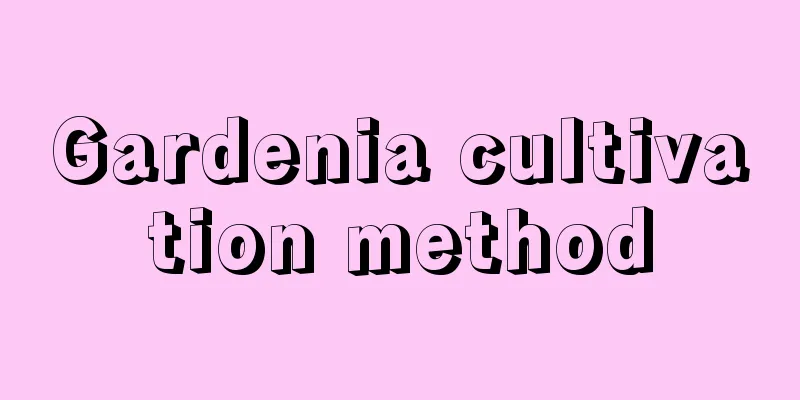Gardenia cultivation method

|
Many people particularly appreciate the beauty of gardenia with its evergreen leaves, white flowers and fresh fragrance. If you want to grow gardenias well at home, it is crucial to learn how to grow gardenias. 1. Watering Gardenia prefers a humid environment. During the active growing months of April to September, keep the soil moist. Water the plants about once every 3 days in spring, once in the morning and once in the evening in summer, about 2 to 3 times a week in autumn, and reduce the frequency of watering in winter, waiting until the soil is completely dry before watering with warm water. 2. Fertilization When planting or repotting, mix an appropriate amount of cake fertilizer or bone meal into the soil as base fertilizer. During the growing period, apply diluted organic liquid fertilizer once a month. Before flower buds form in spring, apply potassium dihydrogen phosphate fertilizer once a week to promote flower bud differentiation, and stop fertilizing after flower buds are formed. Avoid fertilizing during the flowering period. After the flowers fade, you can apply potassium dihydrogen phosphate again to help the plant's later growth. 3. Soil The ideal gardenia growing soil is a mixture of 4 parts peat soil, 1 part perlite and 1 part pine needle soil. This soil is nutrient-rich, moisture-retaining, loose and breathable, and slightly acidic, making it very suitable for gardenias. 4. Lighting Gardenias need plenty of sunlight, especially in spring, autumn and winter. However, during the high temperatures in summer, appropriate shade is needed to prevent the leaves from being sunburned and turning yellow. 5. Pruning The best time for pruning is during the growing season from May to July and the dormant period in December. Appropriately cut off branches and leaves that are too long, too dense or poorly grown, as well as the messy parts that affect the appearance. After the flower buds grow out, remove the weak ones and keep the strong ones to ensure the quality of flowering. 6. Notes Avoid exposing gardenias to the sun for long periods of time to prevent sunburn on the leaves. At the same time, do not place it in a dark environment for a long time, so as not to affect photosynthesis and cause yellowing or falling leaves. Gardenia is not cold-resistant. The temperature should be kept above 10℃ in winter and avoid being below 5℃ to prevent frostbite. Gardenias prefer slightly acidic soil and should be watered with acidic water. If tap water is used, it should be left to stand for 24 hours or exposed to the sun before use to prevent the soil from becoming alkaline. The above are the maintenance methods and precautions for gardenias. Doing these things well can ensure that the gardenias grow luxuriantly, bloom profusely, and emit a rich fragrance.
|
<<: Planting and cultivation methods of lilies
>>: How to water succulent plants in summer?
Recommend
Anthurium hydroponic cultivation method, what to use to fix
1. Suitable lighting Anthurium is suitable for gr...
Using domestic waste to grow flowers will make the flowers strong and the seedlings thriving!
garlic effect: Garlic has many functions in flowe...
What to drink with dandelion tea
1. Rose Rose has the effect of promoting blood ci...
When is the best time to repot Monstera
Monstera repotting time Generally, the newly purc...
How to water the potted money tree
Key points for watering potted money trees Potted...
When and how to plant herbs
Herb Planting Time If you want vanilla to grow vi...
How to deal with waterlogging and root rot? How long does it take for waterlogging in the soil to cause root rot?
1. Causes of waterlogging and root rot 1. Water a...
Apple leaf cultivation methods and precautions
1. Matrix selection Apple leaves grow well in san...
If you don't know how to take care of the roots, no matter how many flowers you grow, they will surely die.
1. Clivia root care method How to induce roots of...
How to grow Hydrangea paniculata
1. Soil When growing Hydrangea paniculata, be sur...
How to graft Ophiopogon japonicus onto Schlumbergera
Steps and methods of grafting Material preparatio...
After eating passion fruit, spread the seeds in a pot. It will produce 3 fruits a year, 100 each time.
Passion fruit planting steps 1. Seed selection Pr...
If you prune roses like this, the flowers will be abundant and the branches will be strong, and they will bloom every year!
What are the benefits of pruning roses? 1. The ma...
How to prune mimosa
When to prune mimosa Mimosa is very resistant to ...
How to make small ball rose bloom
1. Soil suitability If you want the rose to bloom...









